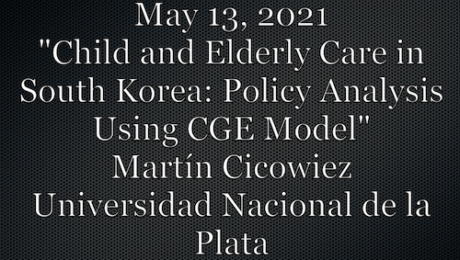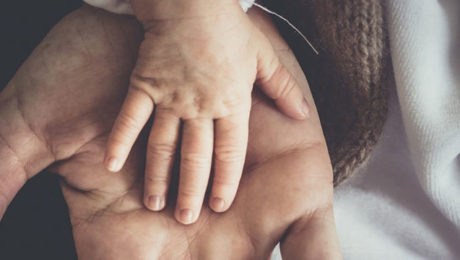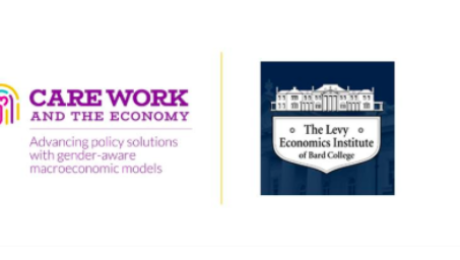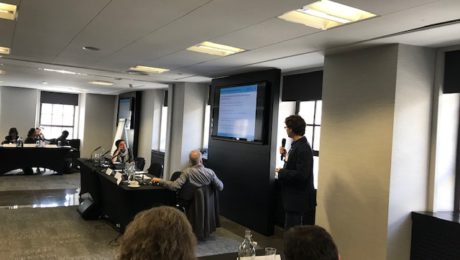Child and Elderly Care in South Korea: Policy Analysis Using CGE Model
In Korea, fertility is constantly decreasing, and it is currently very low, the size of the elderly population is going up, and at the same time, the size of the child population is going down, the gender wage gap is the highest among the OECD countries at about 35%. Given this context, Dr. Martin Cicowiez (Universidad Nacional de la Plata) discussed a computable general equilibrium (CGE) model for South Korea developed with Hans Lofgren (World Bank) that assessed the impact of different policies related to childcare, elderly care, and the gender wage gap on the distribution of paid care and unpaid care in households, on the second day of the Concluding Annual Meeting.
Dr. Cicowiez stated that a well-structured and disaggregated model could capture the role of government policies in addressing these challenges and further inform policymaking by establishing links between care, female labor force participation, gendered wage discrimination, and social and economic outcomes such as household wellbeing.
The model features three representative households based on their care needs: working-age head with children, working-age head without children, and elderly head. And three simulations: increase in government spending on childcare, increase in government spending on eldercare, and a decrease in the wage gap by 50%. The results show an increase in time spent on paid work for both men and women if there is an increase in government spending on childcare and this increase is higher for females. The effects of increased government spending on elderly care and a decrease in the wage gap are similar but relatively smaller. All three simulations demonstrate a switch from unpaid care to market care services. It is worth noting that females experience decreased leisure when the analysis includes time spent on leisure activities. These results underscore the tradeoffs of macroeconomic policies targeted at care work.
To watch the full presentation, see below.
Written by Praveena Bandara, Research Assistant for the Care Economy Project and PhD student in Economics at American University.
- Published in Conferences, Economic Modeling, Expert Dialogues & Forums, Policy, Rethinking Macroeconomics
What is the Care Economy and Why Should We Care?
In our project, we aim to promote and advocate for gender and socioeconomic equalities. We do this by working to reduce gender gaps in economic outcomes and by showing and properly valuing social and economic contributions of caregivers; and integrating care into macroeconomic policy making toolkits.
In this era of demographic shifts, economic change and chronic underinvestment in care provisioning, innovative policy solutions are desperately needed, now more than ever. Sustainable and inclusive development requires gender-sensitive policy tools that integrate new understandings of care work and its connections with labor market supply and economic and welfare outcomes.
The Care Work and the Economy Project, currently based at the Economics Department of American University and co-led by Maria S. Floro and Elizabeth King, includes more than 30 scholars around the globe, working closely together to provide policy makers, scholars, researchers and advocacy groups with gender-aware data, empirical evidence and analytical tools needed to promote creative macroeconomic and social policy solutions. In the next phase of the project, Care Economies in Context, we will be scaling up our project to include 8 different countries, in 4 global regions. I will be leading this next phase of the project, which will be based at the University of Toronto.
I define Care work is defined broadly as work and relationships that are necessary for the health, welfare, maintenance and protection of all people – young and old, able bodied, disabled, and frail. This definition may seem broad – but care– at its core is a very basic human need and a necessity. Whether we know it or now, we all participate in providing care work – paid or unpaid, and in receiving care every day.
By care economy, I am referring to the sector of economy that is responsible for the provision of care and services that contribute to the nurturing and reproduction of current and future populations. More specifically, it involves child care, elder care, education, healthcare, and personal social and domestic services that are provided in both paid and unpaid forms and within formal and informal sectors.
Care work is important because it is important work that sustains life. It is also important now in particular because it is one of the fastest expanding economic sectors and a major driver of employment growth and economic development around the world. For example, across the OCED, the service sector economy now accounts for over 70 percent of total employment and GDP. In lower- and middle-income countries, it is estimated to comprise nearly 60 percent of GDP. Within the service sector economy, care services is one of the fastest growing subsectors.
The International Labour Organization (ILO) estimates that the global employment in care jobs is expected to grow from 206 million to 358 million by 2030 simply based on sociodemographic changes. The figure will be even more dramatic to 475 million if governments invest resources to meet the UN sustainable development goal targets on education, health, long-term care and gender equality.
In Canada, the service sector already makes up for 75 percent of employment and 78 percent of GDP. Within this sector, healthcare, social assistance and education services are key drivers of economic and employment growth. In the U.S., healthcare is already the largest employer, larger than steel and auto industries put together. In short, our current and future economy is and will be increasing dominated by care services and care work.
However, at the same time, much of the care work continues to be performed for no pay, by families and friends, at home and in communities. This unpaid care work is not including in in our national GDP because GDP only takes into account work that is done for pay in the formal market. Therefore, if we only look at the GDP as a measure of the economy and economy growth, we miss a huge segment of the economy and economic activities. As the pandemic has shown, without both paid or unpaid care work, our economy will not be able to function effectively, nor would it be able to sustain itself.
What we are trying to do in our project is to make the care economy clearer and more visible by measuring and mapping out the size and shape of the economy, and to develop macroeconomic models that would help policymakers and civil society actors to develop better policies and better strategies to ensure more sustainable and equality inducing economic growth.
Listen to the full talk “The Care Work and the Economy Project” to learn about what the care economy is and why we should know more about it, particularly now.
The blog was authored by Ito Peng, contributing researcher for the Understanding and Measuring Care research cluster
- Published in Canada, Child Care, Economic Modeling, Elder Care, Expert Dialogues & Forums, Feminist Economics, OECD
Macroeconomic Policies, Care and Gender in the Post-COVID Era: Part II
Faculti, an organization that presents digital media from leading experts and academics outlining their work, recently released a digital presentation by the Care Work and the Economy Principal Investigator Dr. Maria S. Floro entitled “Macroeconomic Policies, Care and Gender in the Post-COVID Era.” The discussion describes the interconnections between the crisis of care, the deepening ecological crisis and growth and accumulation processes.
There are many common threads with the climate and ecological crisis and the care crisis. Significantly, the idea that economic growth is overall beneficial. The type of economic growth generally pursued worldwide has not only increased stresses put upon the earth’s resource base but also on care labor capacity, which is similarly but wrongly perceived to be of infinite supply. Moreover, arguments that equate economic growth with overall improvement fail to recognize the distributional element of rising income inequality, which is far more nuanced. In fact, among countries that are higher income, gains from economic growth within those nations do not trickle down to everyone. When looking at care, the widening income equality gaps has shifted distribution of care givers across social classes and national boundaries. As a result, the quality and adequacy of care within a single nation can be very different, which exacerbates differences in social reproduction.
At the same time, income inequality has created a solution for the care needs of those that have the means to hire care for children and elderly, because care workers in those sectors are often paid low wages. But for the working poor, hiring care work help is inaccessible due to financial constraints, therefore they rely on their kinship networks to help provide this care. Furthermore, much of the care work burden still falls on women even as they enter to labor force. Economics and social policy in many parts of the world continue to neglect the heavy work burden put upon women and the necessity to balance household care activities and market work. What can also be observed is a global care supply chain, with the migration of women and girls to urban areas to provide care for wealthier families. Care itself is becoming one of the drivers of income inequality.
The economy is not all about material production; it is really about human vision and social provisions. However, an illusion has been created that unpaid care work is a natural resource that serves as an input for market production to promote GDP growth. However, this idea does not take into account that the wellbeing of people, especially the elderly, the sick and children should be an end in and of itself, to achieve sustainable growth. There is much work to be done to address these issues. To begin, economists must envision long term horizons that look forward to future generations while also taking into account the interdependence of life and moral responsibility. They must also integrate care and environmental consequences into our economic policy tools. Overall a new economic paradigm that includes green ecology and feminist economic concerns is needed.
Link to Part 1 of this blog here.
Reflections on Microfinance and the Care Economy
With rollback of the developmental state under the neoliberal policy regime, financial inclusion has come to be adopted as a developmental strategy. Micro-credit schemes, which were initially promoted as tools for gender-empowerment and poverty alleviation, have in the process become increasingly absorbed within the sphere of mainstream private finance. The relatively low rates of default in this sector have attracted an influx of funds from profit oriented financial institutions. The focus has shifted from the sustainability of income generation for borrowers to that of the profitability of the lending institution. Given the higher transaction costs associated with small loans and extending outreach to marginal low income households this change of focus has undermined the social mission of microfinance to reach the poorest and most neglected households. Social priorities are being subordinated to commercial considerations.
The impact of micro-credit on both poverty and gender relations has been extensively studied. However, the implications of the growth of micro-credit for the care-economy, and their repercussions in the wider macro-economy have received less analytical attention. The neglect of the implication microfinance for the provision of care labor is surprising in the light of the original mission of microfinance, which targeted the female worker in rural areas in developing countries, with less access to earning opportunities and disproportionate responsibility for the care work. The increase in market labor implies a claim on the time of working women. In the absence of social provisioning of care, this claim on the labor time of women could lead to a squeeze on the time of rural working women
A simple two-sector post-Keynesian model allows the integration of the role of demand and care work into the analysis of microfinance. This investigation demonstrates is that micro financed enterprises face a structural constraint on the demand side from overall macroeconomic conditions, and on the supply side from the responsibility for unpaid care work borne by the female beneficiary of microfinance. Paradoxically, microfinance has been espoused as a developmental strategy in precisely the period when the role of the developmental state has been eclipsed, and cutbacks in public spending on care provisioning have been prescribed.
Slowdowns in the wider economy, would lower the demand for the output of the microfinance sector, and hence undermine the viability of these enterprises. The capacity of the microfinance sector to provide the impetus to broader demand growth in the economy is likely to be more limited in the absence of public policies to stimulate demand and investment. The capacity of microfinance to alleviate poverty and lift incomes is thus dependent on conditions in, and linkages with the wider macroeconomy. A vibrant and stable macroeconomy is the only sustainable basis for a stable microfinance sector.
We also draw attention to some of the complexities of the impact of microfinance on the provision of care. The home-based nature of microenterprises perpetuates the gendered asymmetries of care responsibility within the household. While higher female earnings can alleviate the burden of care by making care work more effective and by enabling the market to substitute for unpaid care, at the lower income levels and in a context of the inadequate social provision of care the gendered responsibility for care remains a critical constraint for the female beneficiary of micro-finance.
Some clear policy prescriptions emerge from this investigation. Donors and development agencies have been encouraging raising interest rates in order to ensure the viability and profitability of microfinance lenders. Our model suggests that high-interest rates will actually undermine the scope of microfinance as a path to better and sustainable livelihoods for poor households in rural areas. Higher interest rates in this sector impose a higher burden on the labor time of the female worker with a consequent squeeze of care-labor or the own labor time.
More significantly, the analysis suggests that microfinance cannot be an effective path to poverty alleviation or gender empowerment unless it is backed by investment in the social provisioning of care. The success of microfinance as a developmental strategy depends on wider policies that support demand and the social provision of care. There is, in the final analysis, no substitute for a developmental strategy based on public investment in support of both job creation and social provision of care.
This blog was authored by Ramaa Vasudevan and Srinivas Raghavendran are both expert researchers for the Care Work and the Economy Project within the Rethinking Macroeconomics working group. To learn more read the CWE-GAM working paper upon which this blog was based here.
- Published in Economic Modeling, Gender Inequalities, Rethinking Macroeconomics
Policy Brief for Gendering Macroeconomic Analysis and Development: A Theoretical Model for Gender Equitable Development
The CWE-GAM team presents an engendered macroeconomic model as a tool to analyze the role of gender equality and fiscal policy on growth and development.[1]The model incorporates realistic structural features of a market economy –such as excess production capacity and involuntary unemployment– and incorporates an unpaid reproductive sector as well as the physical and social sectors in the public and private market economy. The addition of the unpaid reproductive sector explicitly incorporates the provision of domestic care, establishing a more holistic representation of how the workforce is kept fed, healthy, and able to work. This three-sector model is designed to serve as a tool for policy analysis and gender-responsive budgeting to develop a policy mix targeted toward more gender-equitable development. This brief provides a general overview of the model and example policy analyses.
For complete details of the model and discussion of related literature, please see the full working paper published to the Care Work and the Economy website click here
- Published in Economic Modeling, Gender Inequalities, Policy Briefs & Reports








